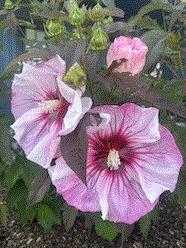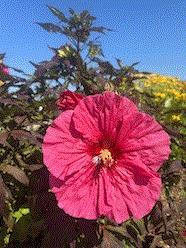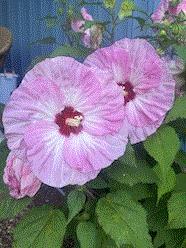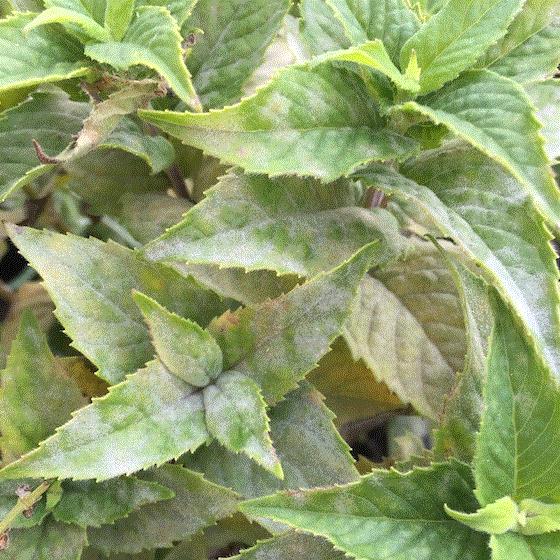What’s Happening Here?
I don’t know about you, but I’ve seen more of this week’s diagnostic challenge this summer than I’ve observed in quite some time. Check out this monarda:
Apart from being slightly malnourished, can you see the other issue this plant has? I’m thinking this should be a super easy, straightforward challenge. Sorry—there are no tricks or games with this one. I’m hoping everyone wins the challenge this week.
The time has come for me to ask, “What’s happening here?” Ponder the possibilities as you read the newsletter and I’ll let you know what’s happening to this monarda in a few minutes.
Summerific Week
One of my favorite summer flowering perennials in my landscape is none other than the hardy hibiscus. Did you know that last week was dedicated to hibiscus? Walters Gardens has dubbed the first week of August as "Summerific Week" to celebrate and promote their impressive line of Summerific hardy hibiscus.
(I apolgize for the belated notice—I intended for the newsletter to be sent out last week when it was indeed Summerific Week, however, as you can tell it's no longer officially Summerific Week, but I believe it's never too late to promote a good plant.)
The Summerific Hibiscus are impressive and have many desirable features. Let me start off with their flower power—the Summerific cultivars are indeterminate, which means they produce flower buds along the length of the stem, not just near the top of the plant, and they have large 8-in. colorful flowers. Additionally, these hibiscus grow fast, but are sturdy plants. They have various leaf shapes and colors, and are cold hardy to Zone 4. Check out a few of the colorful flowers I just took from my gardens:
|

Cherry Choco Latte
|

Evening Rose
|

Spinderella
|
During Summerific Week, industry professionals, garden writers and social media influencers are asked to post photos and videos on social media and tag them in their images on Facebook or use #SummerificWeek on Instagram featuring their hibiscus. There were a lot of fun images and videos I saw on Instagram. Be sure to search for them on these platforms.
If you have an image, video and/or comment you’d like to share, please post them to help improve the awareness of these great summer-flowering perennials. Join in on hibiscus mania and share your photos and comments. Be sure to include #SummerificWeek and tag @waltersgardens in your post to improve the success of this initiative.

A Warm Welcome
 Dr. Matthew Chappell, long time Nursery & Landscape Insider newsletter Editor-at-Large recently passed the torch and editorial responsibilities of the newsletter to the well-versed and equally qualified Dr. Jeb Fields, faculty member at Louisiana State University Agricultural Center’s Hammond Research Station faculty, where his research and extension program is focused on ornamental plant production parameters and resource efficiency.
Dr. Matthew Chappell, long time Nursery & Landscape Insider newsletter Editor-at-Large recently passed the torch and editorial responsibilities of the newsletter to the well-versed and equally qualified Dr. Jeb Fields, faculty member at Louisiana State University Agricultural Center’s Hammond Research Station faculty, where his research and extension program is focused on ornamental plant production parameters and resource efficiency.
Before I share more on Jeb, I'd like to take a quick moment to thank Matthew for all the great content he's shared with us in his newsletter over the past seven years, and to wish him luck and success with the next chapter of his life.
Jeb has already completed three newsletters and is off to a great start putting out some great content. First, I’d like to congratulate Dr. Fields and welcome him to the Ball Publishing team. Next, I’d like to give you a glimpse of some of the content in his latest edition.
Three Woody Plants Win the Coveted Retailers’ Choice Award
Cultivate’23 wrapped up a couple weeks ago, but the excitement continues. The Garden Center Group announced 15 winners for the 2023 Retailers’ Choice Awards. This year’s winners include three woodies that are sure to impress.
First up is Hydrangea Eclipse from Bailey Nurseries—First Editions. This new addition to the First Editions family is a hydrangea that features dark purple foliage and cranberry blooms. Eclipse holds the dark color well, even after being cut back and in warmer climates.
Hydrangeas are popular this year, as the next winner is the new red reblooming hydrangea Cherry-Go-Round from Bloomin’ Easy. This heavy rebloomer offers eye-catching cherry red flowers that deepen in the shade as they mature.
Finally, it seems reds are hot this year. The third award winner on this list is Garden Gems Amethyst Redbud from Star Roses and Plants. Judges mentioned that this Cercis has some of the deepest purple color, which is expected to hold throughout the heat of summer.
Click
HERE to check out the latest edition of
Nursery and Landscape Insider, including coverage from Jeb's recent tour of a peat bog up in Canada. If you like what you see,
please subscribe—after all, this twice-per-month newsletter is free.

The Answer is …

At the top of the newsletter, I challenged you to determine the cause of the problem on this monarda. There really are only two obvious possibilities that I can think of. First is spray residue and second is powdery mildew, but which one is it? My subtle clues were "this summer" and the plant monarda. If you’ve been around monarda, then you’re likley already aware that it's susceptible to powdery mildew during the summer and that’s precisely what’s going on here.
Perhaps the initial image threw you off course since the mildew is covering the entire plant. Initially, powdery mildew develops as small white talcum powder-like colonies on the leaves. If uncontrolled, it can cover the entire above-ground portions of the plant.
Not that it’s good news by any means, but although powdery mildew significantly reduces the plant’s appearance and marketability, as well as reduces its growth and vigor during an active infection, it seldom, if ever, kills the host plant. I suppose that’s sort of a glass-half-full perspective there.

Diving Deeper
Altough powdery mildew can be problematic in the landscape or for growers, it’s actually a pretty fascinating disease (now my inner geek is really coming out).
There are several fungal pathogens (Erysiphe, Leveillula, Microsphaera, Podosphaera and Spaerotheca) that cause powdery mildew diseases. One characteristic that separates mildews from other fungal pathogens is they're host specific, which means the powdery mildew that infects one type of plant is usually different from the mildew that attacks another. However, they'll often attack plants within the same family. Some of the powdery mildew diseases are very host specific and only attack one or two different species of plants, while others have a wide host range and can infect a wide range of plant species. I think this aspect of these pathogens is pretty cool.
Another characteristic that differentiates powdery mildew diseases from many other pathogens is they're all obligate parasites. This means they can only grow and reproduce on live plant tissues. The fungus will die without the presence of live plants (maybe that’s why they don’t kill their hosts).
Unlike many foliar diseases, powdery mildew doesn't require free water on leaf surfaces for infections to occur. Extended periods of high relative humidity (greater than 70%), particularly at night, triggers the formation of new spores and the onset of new outbreaks. The initial infections require high relative humidity and moderate temperatures; disease infections occur more rapidly when the temperatures are warmer (70 to 80F is ideal). Once the pathogen has infected the host plant, the relative humidity is no longer a factor, as powdery mildew can prosper regardless of the humidity once it’s inside the plant.
Severe case of powdery mildew on veronica.
Powdery mildew spores are spread by air movement. Once the spores land on plants, it takes three to seven days for an infection to develop and form visible colonies, provided favorable conditions are present. The spores release, germinate and cause infections without a film of water on plant surfaces. The fungus grows into small colonies on the leaves, obtaining nutrients from the plant by penetrating into leaf cells with specialized structures called haustoria.
Managing Powdery Mildew
To decrease the likelihood of infections, take steps to manage the humidity if at all possible (this may be easier said than done). Growing susceptible crops at wide plant spacings, increasing air circulation around the plants and using preventative programs can greatly decrease the occurrence or severity of powdery mildew infections.
There are several biosolution options available for controlling powdery mildew. Some of the most effective biorational compounds contain the active ingredients Bacillus subtilus, hydrogen peroxide, neem oil or potassium bicarbonate. When using these products, it’s best to use them preventatively and is very important to achieve complete coverage; multiple applications are often necessary.
There are many traditional fungicides that provide very good to excellent control of powdery mildew diseases. Fungicides containing the active ingredients azoxystrobin, myclobutanil, piperalin, pyraclostrobin, pyriofenone, triadimefon and triflumizole are highly effective at controlling powdery mildew diseases. If chemical controls are necessary, be sure to rotate between chemical classes to reduce the likelihood of the mildew diseases from developing resistance to these products.





Thanks for reading this edition of Perennial Pulse. My email is paul@opelgrowers.com if you have any comments, article suggestions or if you'd just like to say hello.
Best regards,

Paul Pilon
Editor-at-Large—Perennial Pulse
Director of Growing—Opel Growers
This email was received by you and 34,873 other fine subscribers!
If you're interested in advertising in Perennial Pulse, contact Kim Brown ASAP and she'll hook you up.